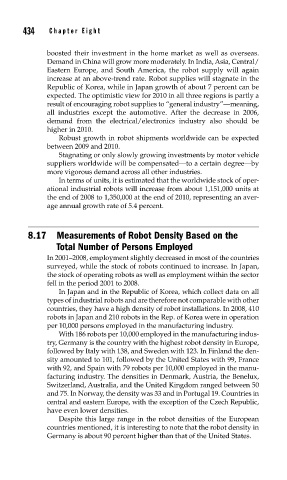Page 481 - Sensors and Control Systems in Manufacturing
P. 481
434
Ei g h t
Cha p te r
boosted their investment in the home market as well as overseas.
Demand in China will grow more moderately. In India, Asia, Central/
Eastern Europe, and South America, the robot supply will again
increase at an above-trend rate. Robot supplies will stagnate in the
Republic of Korea, while in Japan growth of about 7 percent can be
expected. The optimistic view for 2010 in all three regions is partly a
result of encouraging robot supplies to “general industry”—meaning,
all industries except the automotive. After the decrease in 2006,
demand from the electrical/electronics industry also should be
higher in 2010.
Robust growth in robot shipments worldwide can be expected
between 2009 and 2010.
Stagnating or only slowly growing investments by motor vehicle
suppliers worldwide will be compensated—to a certain degree—by
more vigorous demand across all other industries.
In terms of units, it is estimated that the worldwide stock of oper-
ational industrial robots will increase from about 1,151,000 units at
the end of 2008 to 1,350,000 at the end of 2010, representing an aver-
age annual growth rate of 5.4 percent.
8.17 Measurements of Robot Density Based on the
Total Number of Persons Employed
In 2001–2008, employment slightly decreased in most of the countries
surveyed, while the stock of robots continued to increase. In Japan,
the stock of operating robots as well as employment within the sector
fell in the period 2001 to 2008.
In Japan and in the Republic of Korea, which collect data on all
types of industrial robots and are therefore not comparable with other
countries, they have a high density of robot installations. In 2008, 410
robots in Japan and 210 robots in the Rep. of Korea were in operation
per 10,000 persons employed in the manufacturing industry.
With 186 robots per 10,000 employed in the manufacturing indus-
try, Germany is the country with the highest robot density in Europe,
followed by Italy with 138, and Sweden with 123. In Finland the den-
sity amounted to 101, followed by the United States with 99, France
with 92, and Spain with 79 robots per 10,000 employed in the manu-
facturing industry. The densities in Denmark, Austria, the Benelux,
Switzerland, Australia, and the United Kingdom ranged between 50
and 75. In Norway, the density was 33 and in Portugal 19. Countries in
central and eastern Europe, with the exception of the Czech Republic,
have even lower densities.
Despite this large range in the robot densities of the European
countries mentioned, it is interesting to note that the robot density in
Germany is about 90 percent higher than that of the United States.

